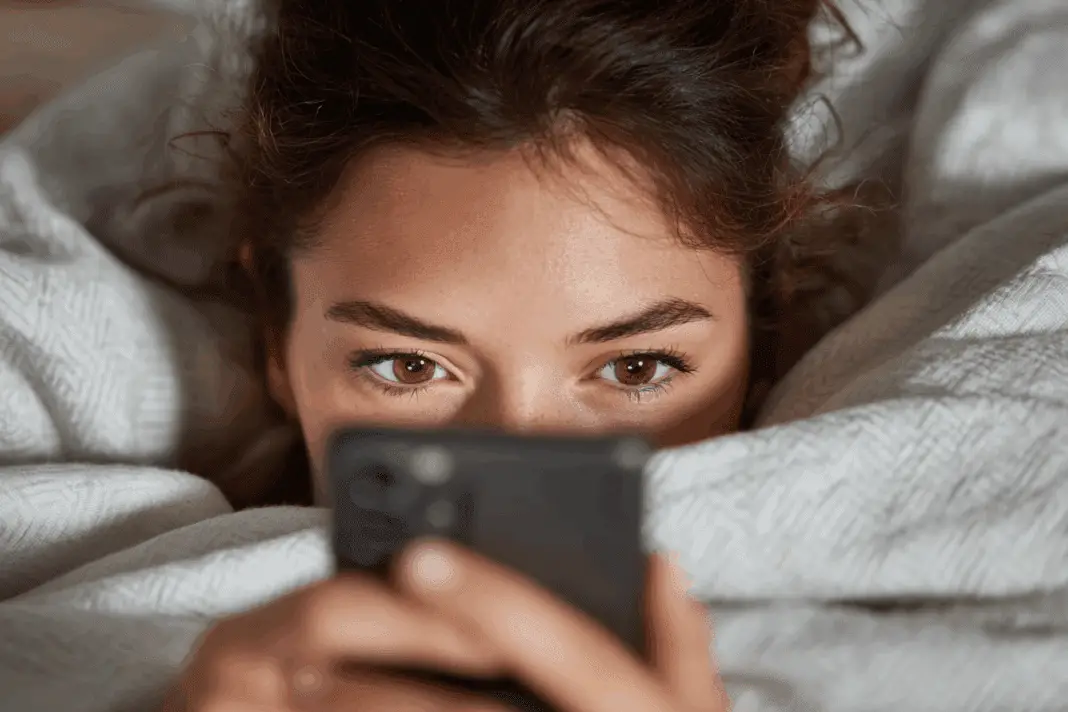Most people check their phones over 150 times per day, but there’s one common habit that’s quietly damaging their eyesight without them realizing it. While everyone talks about blue light exposure, the real culprit behind widespread eye problems is actually how we position and use our devices during those countless hours of daily screen time.
Holding your phone too close causes permanent damage
That comfortable position where your phone rests just inches from your face while lying in bed or sitting on the couch is actually training your eyes for nearsightedness. When screens are held closer than arm’s length, the eye muscles work overtime to focus on nearby objects, gradually reshaping the eyeball itself. This constant strain forces the eye to elongate slightly, which is exactly how myopia develops and progresses over time.
The ideal viewing distance for any screen is about 25 inches away, roughly an arm’s length from your face. Research shows that maintaining proper distance significantly reduces the risk of developing digital eye strain and myopia progression. Position your phone so you’re looking slightly downward at the screen, which also helps maintain better posture and reduces neck strain that often accompanies prolonged phone use.
Staring without blinking creates chronic dry eyes
Normal blinking happens about 15 times per minute, but phone use cuts this rate in half without most people noticing. When absorbed in scrolling through social media or reading text messages, the natural blink reflex slows down dramatically. This reduced blinking prevents the even distribution of tears across the eye surface, leading to dry, irritated eyes that feel gritty or burn throughout the day.
The tear film that coats the eye needs regular refreshing through blinking to maintain proper moisture and clear vision. Extended periods without adequate blinking cause the tear film to evaporate faster than it can be replenished. Making a conscious effort to blink more frequently while using devices, combined with artificial tears when needed, can help restore proper eye lubrication and reduce discomfort.
Poor lighting conditions strain your eye muscles
Using phones in dimly lit rooms or bright sunlight forces the eyes to constantly adjust between different light levels, creating unnecessary stress on the visual system. When screen brightness doesn’t match the surrounding environment, the pupils work harder to regulate how much light enters the eye. This constant adjustment leads to eye fatigue, headaches, and difficulty focusing on other tasks after extended phone use.
The contrast between a bright screen and dark surroundings is particularly problematic during nighttime phone use. Screen brightness should ideally match the ambient lighting in your environment to reduce eye strain. Most phones now include automatic brightness adjustment features, but manually fine-tuning the settings based on your current location provides even better protection for your eyes.
Never taking screen breaks exhausts your vision
Continuous phone use without breaks prevents the eye muscles from relaxing and recovering from sustained close-up focus. Just like any other muscle in the body, the tiny muscles that control eye focusing need periodic rest to function properly. Hours of uninterrupted screen time can lead to accommodation spasm, where the focusing muscles become stuck in the near-vision position, making it difficult to see distant objects clearly.
The 20-20-20 rule provides an effective framework for giving eyes regular relief during device use. Every 20 minutes, look at something 20 feet away for at least 20 seconds to allow the focusing muscles to relax. This simple practice can prevent the buildup of eye strain and help maintain comfortable vision throughout long periods of phone use.
Late night phone use disrupts natural sleep cycles
Evening phone use exposes the eyes to blue light when the body expects darkness, confusing the brain’s natural sleep-wake cycle. Blue light naturally occurs in sunlight and signals the body to stay alert and awake. When phones emit this same type of light during nighttime hours, it suppresses melatonin production, the hormone responsible for making us feel sleepy and preparing the body for rest.
Poor sleep quality directly impacts eye health by reducing the time available for natural repair and recovery processes. Sleep deprivation increases the risk of dry eyes, irritation, and infection while making existing eye strain symptoms worse. Using night mode settings or avoiding phone use 1-2 hours before bedtime helps restore natural sleep patterns and gives eyes the recovery time they need.
Ignoring early warning signs leads to bigger problems
Headaches, blurred vision, and eye discomfort after phone use are clear signals that current habits are causing damage, yet most people push through these symptoms without making changes. Early signs of digital eye strain include difficulty focusing after screen use, increased sensitivity to light, and eyes that feel tired or heavy. These symptoms typically worsen gradually, making it easy to dismiss them as temporary annoyances rather than warning signs.
Ignoring these early indicators allows underlying problems to develop and become more difficult to reverse. Digital eye strain symptoms can progress from occasional discomfort to chronic issues that affect daily activities and quality of life. Addressing symptoms early through better phone habits and regular eye examinations helps prevent minor problems from becoming major vision concerns that require more intensive treatment.
Using phones while multitasking increases eye stress
Switching attention between phone screens and other visual tasks forces the eyes to constantly refocus at different distances, creating additional strain on the visual system. Common scenarios like checking phones while watching TV, reading printed materials, or working on computers require rapid accommodation changes that tire the eye muscles faster than single-task phone use. This constant switching also reduces overall visual efficiency and can lead to focusing difficulties.
The brain processes visual information differently when attention is divided between multiple screens or tasks, requiring more effort to maintain clear focus on each one. Multitasking with devices can amplify the symptoms of digital eye strain and make it harder to notice when eyes need a break. Focusing on one visual task at a time allows the eyes to settle into a comfortable focusing distance and reduces the overall workload on the visual system.
Dirty screens force eyes to work harder
Smudges, fingerprints, and dust on phone screens reduce visual clarity and force the eyes to strain harder to see through the layer of grime. Most people don’t realize how much their dirty screens contribute to eye fatigue until they clean them and notice the immediate improvement in comfort and clarity. Oils from fingers and environmental particles scatter light as it passes through to the eye, creating a subtle but constant source of visual interference.
A clean screen provides crisp, clear images that require less effort from the focusing system to interpret. Regular cleaning of phone screens with appropriate cleaning materials removes the buildup of oils and particles that contribute to eye strain. This simple maintenance step can provide immediate relief for people experiencing digital eye strain symptoms and makes longer periods of phone use more comfortable for the eyes.
Skipping regular eye exams misses developing problems
Many vision changes from phone use develop gradually and aren’t noticeable until they’ve progressed significantly, making regular professional eye examinations crucial for early detection. Eye care professionals can identify subtle changes in vision, eye muscle function, and overall eye health that indicate problems before they become symptomatic. They can also provide personalized recommendations for device use based on individual risk factors and existing vision conditions.
Comprehensive eye exams can detect myopia progression, dry eye disease, and other conditions related to digital device use while they’re still easily manageable. Regular monitoring allows for adjustments in phone habits and corrective measures before permanent damage occurs. Eye care professionals can also recommend specific treatments or protective measures based on current symptoms and individual usage patterns, providing targeted solutions rather than generic advice.
The key to protecting your vision lies in recognizing that small daily habits compound over time into significant health consequences. By adjusting phone positioning, taking regular breaks, and paying attention to early warning signs, most people can continue enjoying their devices while preserving their eyesight for years to come.

